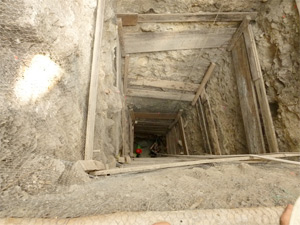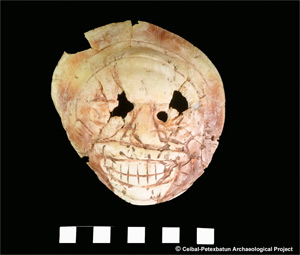Ceibal Archaeological Project
Project Zooarchaeologist: Ashley Sharpe

What can animal bones and shells tell us about the rise of Maya society? With a history spanning some 2,000 years, the site of Ceibal (formerly “Seibal”) has one of the longest occupation sequences anywhere in the Maya area, making it a unique place to investigate the role of animals in the development of Maya civilization.
Ceibal is located in the humid lowland Petexbatun region of Guatemala, near the sites of Aguateca and Dos Pilas. Excavations begun in the 1960s by Harvard University (Willey et al. 1975, 1990) focused primarily on the Late and Terminal Classic period (A.D. 550 – 900) to better understand how political tensions between Ceibal and its neighbors led to the eventual abandonment of this site and others in the region (Pohl 1985, Sabloff 1975). But their work also revealed that this large Late Classic site had an equally impressive Preclassic past, dating to at least 1000 B.C.
Over the last decade, a second phase of intensive research has been initiated in order to dig deeper into the remote Preclassic levels of occupation. These new investigations, conducted by Drs. Takeshi Inomata and Daniela Triadan from the University of Arizona and archaeologists from the University of San Carlos, Guatamala, have already made some surprising discoveries, including a series of extensive Middle Preclassic (1000 – 400 B.C.) caches in the central plaza. These deposits consist of numerous ceramic vessels, obsidian, animal bones and shells, and even the occasional human burial, all evidence indicating this was once an important Preclassic location for special ritual performances. Comparison of the plaza’s architectural layout and polished jade axe caches found in ritual deposits from the bases of the temples surrounding the plaza strongly suggest cultural ties with Central Mexico, particularly the Olmec civilization. Ongoing investigations are investigating how this early relationship with the Central Mexicans influenced the development of Maya political and social life in the Petexbatun region (Inomata et al. 2009, Ponciano et al. 2007).

Toward this end, graduate student Ashley Sharpe has been excavating and analyzing the zooarchaeological material from Ceibal for the past four years in an effort to answer a number of questions about this unique Maya site: How did the use of animal resources change over time as Ceibal reached and descended from its two political apogees, first during the Mid-Late Preclassic and later during the Late-Terminal Classic? Did the acquisition and control of animals and their products influence these trends? Did the role of animal resources vary between certain status groups, or between residences of the site center versus the residential peripheries? These questions are contextualized within the broader research at the site, allowing Sharpe to ask such questions as: What types of animals were included in the cache offerings at the center of the site, and why? Can we distinguish trade patterns with the Central Mexican area, such as identifying marine shells that may have been traded upriver to Ceibal?Ongoing analyses over the next year will soon provide answers to at least some of these questions, and hopefully give us a better understanding of how Maya society developed and changed at this site across two millennia.
References
Inomata, Takeshi, Daniela Triadan, Otto Román, Estela Pinto, Jessica Munson, and Kenichiro Tsukamoto. 2009. Cambios Sociales Durante los Períodos Preclásico y Clásico en Ceibal: Los Resultados del Proyecto Arqueológico Ceibal Petexbatun. In XXII Simposio de Investigaciones Arqueológicas en Guatemala, 2008, edited by Juan Pedro Laporte, Bárbara Arroyo, and Héctor E. Mejía, pp. 593-602. Ministerio de Cultura y Deportes, Instituto de Antropología e Historia, and Asociación Tikal, Guatemala.
Pohl, Mary Deland Pohl. 1985. Privileges of Maya Elites: Prehistoric Vertebrate Fauna from Seibal. Peabody Museum of Archaeology and Ethnology, Harvard University v. 77, 1985, p.133-145, ill. Cambridge, Mass.
Ponciano, Erick M., Takeshi Inomata, Danieal Triadan, Estela Pinto, Jessica Munson, and Omar Schwendener. 2007. Revisitando Ceibal: Cambios sociales durante el Preclásico y Clásico Terminal en la región del Pasión. In XX Simposio de Investigaciones Arqueológicas en Guatemala 2006, edited by Juan Pedro Laporte, Bárbara Arroyo, and Héctor E. Mejía, pp. 379-390. Ministerio de Cultura y Deportes, Instituto de Antropología e Historia, and Asociación Tikal, Guatemala.
Sabloff, Jeremy A. 1973. Continuity and disruption during Terminal Late Classic times at Seibal: Ceramic and Other Evidence. In Classic Maya Collapse. Edited by Culbert, T. Patrick, pp. 107-131. Albuquerque.
Willey, Gordon Randolph. 1990. General Summary and Conclusion. Memoirs of the Peabody Museum of American Archaeology and Ethnology, Harvard University Memoirs. Volume 17, pp. 175-272.
Willey, Gordon Randolph, A. Ledyard Smith, Gair Tourtellot III, and Ian Graham. 1975. Excavations at Seibal. Departament of Petén, Guatemala. Introduction: The Site and Its Setting. Memoirs of The Peabody Museum of Archaeology and Ethnology. Volume 13, Number 1. Harvard University.